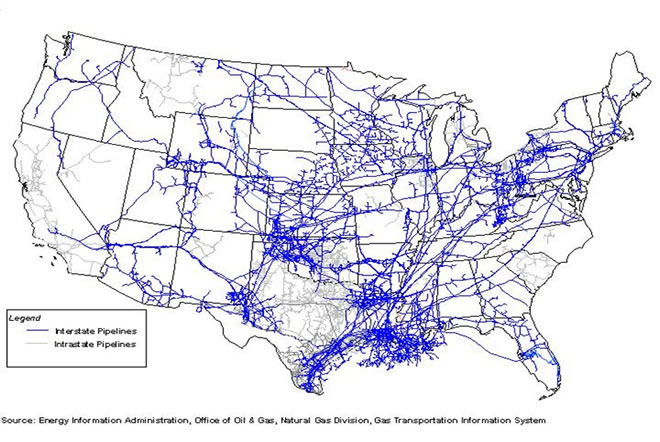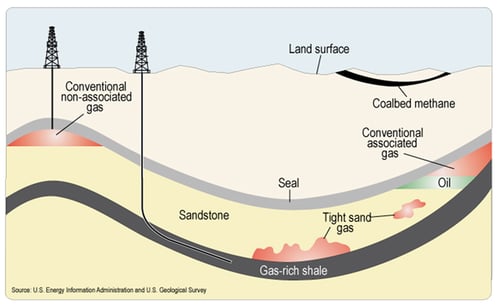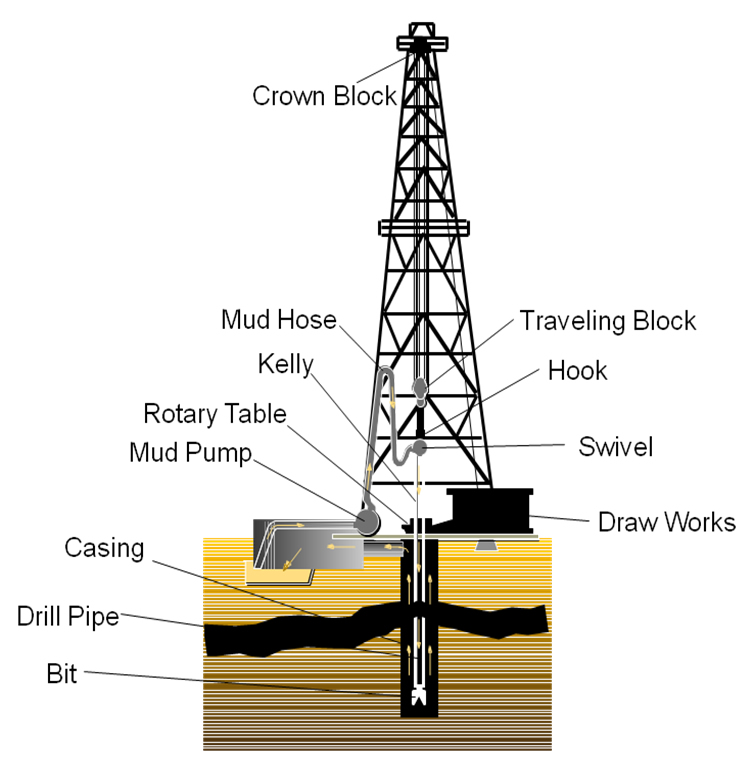Distribution System
Natural gas has used to heat American homes and generate power for years. Every day in the U.S., several billion cubic feet of natural gas travel through a high-tech underground pipeline delivery system to more than 64 million customers. Here's a closer look:
Stability
Natural gas is produced in 20 states. High-strength pipelines act like interstate highways, moving huge amounts of natural gas thousands of miles. Computerized systems tell pipeline companies where gas is needed most, and then find the most efficient way to get it there. To help avoid interruption of service, pipelines are equipped with shutoff valves that let companies reroute gas to other lines, while a specific line is being serviced. In addition, many gas companies store natural gas during warmer months to help ensure that home-heating customers can depend on the fuel in colder months.
For more information, visit the American Gas Association website.
The Delivery System
Natural gas flows from deep inside the earth into producing wells. From there, it enters gathering pipelines and then large transmission pipes that crisscross the nation. After traveling up to 700 miles in a day, the natural gas arrives at the local utility. Some of the gas is stored underground for later use. The rest is sent through a network of pipes to homes or businesses. The American Gas Association says the normal pressure for sending the natural gas through these pipes is less than the pressure created by a child blowing bubbles through a straw in a glass of milk.
How Does the Natural Gas Delivery System Work?
Gas flowing from higher to lower pressure is the fundamental principle of the natural gas delivery system. The amount of pressure in a pipeline is measured in pounds per square inch. From the well, the natural gas goes into "gathering" lines, which are like branches on a tree, getting larger as they get closer to the central collection point.
Gathering Systems
A gathering system may need one or more field compressors to move the gas to the pipeline or the processing plant. A compressor is a machine driven by an internal combustion engine or turbine that creates pressure to "push" the gas through the lines. Most compressors in the natural gas delivery system use a small amount of natural gas from their own lines as fuel.
Some natural gas gathering systems include a processing facility, which performs such functions as removing impurities like water, carbon dioxide or sulfur that might corrode a pipeline, or inert gases, such as helium, that would reduce the energy value of the gas. Processing plants also can remove small quantities of propane and butane. These gases are used for chemical feed stocks and other applications.
The Transmission System
From the gathering system, the natural gas moves into the transmission system, which is composed of about 272,000 miles of high-strength steel pipe ranging from 20 inches to 42 inches in diameter.
These large transmission lines for natural gas can be compared to the nation's interstate highway system for cars. They move large amounts of natural gas thousands of miles from the producing regions to local distribution companies (LDCs). The pressure of gas in each section of line typically ranges from 200 pounds to 1,500 pounds per square inch, depending on the type of area in which the pipeline is operating. As a safety measure, pipelines are designed and constructed to handle much more pressure than is ever actually reached in the system. For example, pipelines in more populated areas operate at less than one-half of their design pressure level.
Many major interstate pipelines are "looped" - there are two or more lines running parallel to each other in the same right of way. This provides maximum capacity during periods of peak demand. The pipeline rights of way are usually 100 feet wide and are leased from landowners with restrictions on construction activities to minimize the potential for accidental damage.
Compressor Stations
Compressor stations are located approximately every 50 to 60 miles along each pipeline to boost the pressure that is lost through the friction of the natural gas moving through the steel pipe. Many compressor stations are completely automated, so the equipment can be started or stopped from a pipeline's central control room. The control center also can remotely operate shut-off valves along the transmission system. The operators of the system keep detailed operating data on each compressor station, and continuously adjust the mix of engines that are running to maximize efficiency and safety.
Natural gas moves through the transmission system at up to 30 miles per hour, so it takes several days for gas from Texas to arrive at a utility receipt point in the Northeast. Along the way, there are many interconnections with other pipelines and other utility systems, which offers system operators a great deal of flexibility in moving gas.
Linepack
A 50-mile section of 42-inch transmission line operating at about 1,000 pounds of pressure contains about 200 million cubic feet of gas - enough to power a kitchen range for more than 2,000 years. The amount of gas in the pipe is called the "linepack."
By raising and lowering the pressure on any pipeline segment, a pipeline company can use the segment to store gas during periods when there is less demand at the end of the pipeline. Using linepack in this way allows pipeline operators to handle hourly fluctuations in demand very efficiently.
Natural gas pipelines and utilities use very sophisticated computer models of customer demand for natural gas, which relate daily and hourly consumption trends with seasonal and environmental factors. That's why customers can depend on the reliability of natural gas - when it's needed, it's there.
Gate Stations
When the natural gas in a transmission pipeline reaches a local gas utility, it normally passes through a "gate station." Utilities frequently have gate stations receiving gas at many different locations and from several different pipelines. Gate stations serve three purposes. First, they reduce the pressure in the line from transmission levels (200 to 1,500 pounds) to distribution levels, which range from 1/4 pound to 200 pounds. Then an odorant, the distinctive sour scent associated with natural gas, is added, so that consumers can smell even small quantities of gas. Finally, the gate station measures the flow rate of the gas to determine the amount being received by the utility.
The Distribution System
 |
From the gate station, natural gas moves into distribution lines or "mains" that range from 2 inches to more than 24 inches in diameter. Within each distribution system, there are sections that operate at different pressures, with regulators controlling the pressure. Some regulators are remotely controlled by the utility to change pressures in parts of the system to optimize efficiency. Generally speaking, the closer natural gas gets to a customer, the smaller the pipe diameter is and the lower the pressure is.
The gas utility's central control center continuously monitors flow rates and pressures at various points in its system. The operators must ensure that the gas reaches each customer with sufficient flow rate and pressure to fuel equipment and appliances. They also ensure that the pressures stay below the maximum pressure for each segment of the system. Distribution lines typically operate at less than one-fifth of their design pressure.
As gas flows through the system, regulators control the flow from higher to lower pressures. If a regulator senses that the pressure has dropped below a set point it will open accordingly to allow more gas to flow. Conversely, when pressure rises above a set point, the regulator will close to adjust. As an added safety feature, relief valves are installed on pipelines to vent gas harmlessly, if a line becomes over pressured and the regulators malfunction.
Sophisticated computer programs are used to evaluate the delivery capacity of the network and to ensure that all customers receive adequate supplies of gas at or above the minimum pressure level required by their gas appliances.
Distribution mains are interconnected in multiple grid patterns with strategically located shut-off valves, so the utility can perform maintenance of its lines without ever shutting off a customer.




